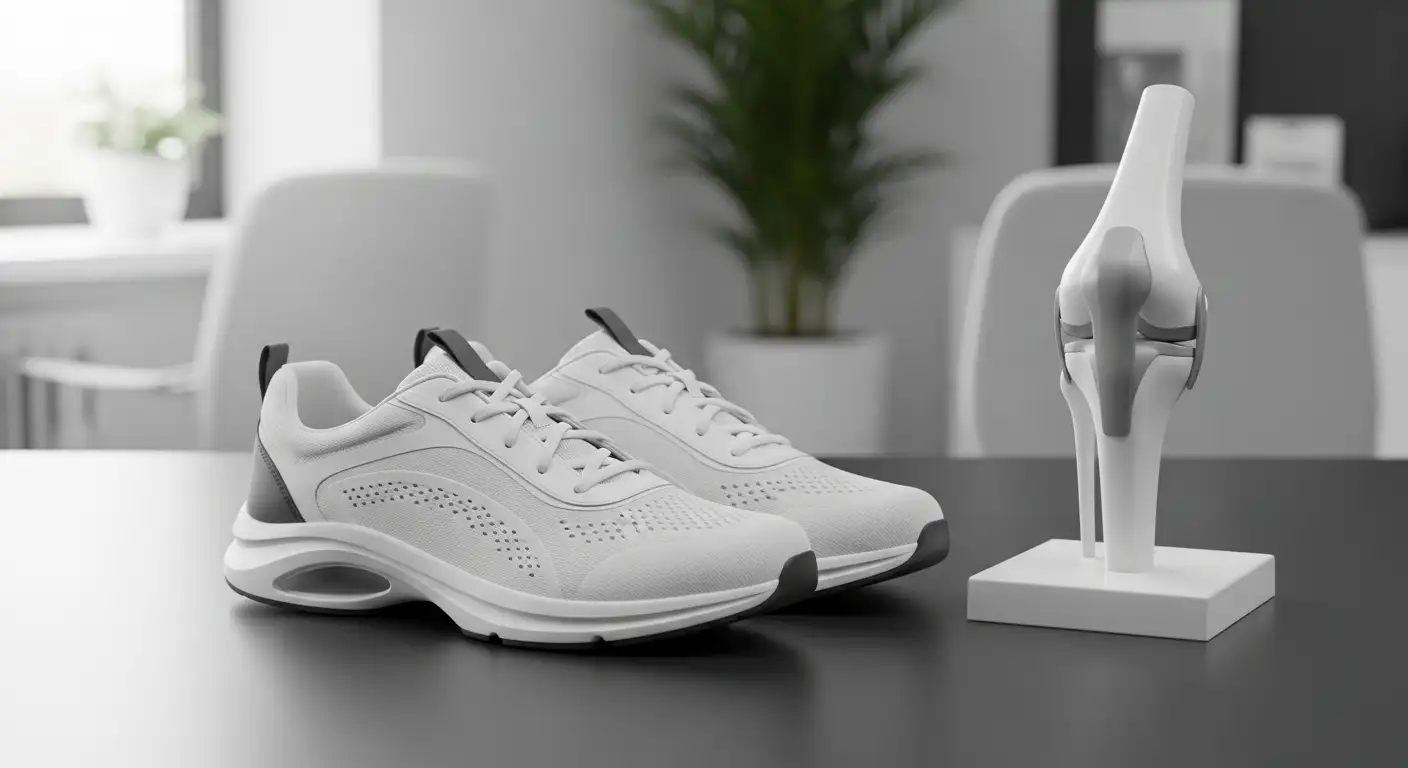
Effective Exercises for Quad Strengthening
Strengthening the quadriceps is essential for overall knee health and functionality. Several exercises focus on developing quad muscle strength, leading to better stability and injury prevention.
Squats for Quad Strength
Squats are a powerful exercise for enhancing quad strength. This compound movement engages multiple lower body muscles, including the quadriceps, hamstrings, and glutes. To effectively perform a squat, individuals should maintain a straight back, keeping their feet shoulder-width apart and lowering their body as if sitting in a chair.
Type of SquatPrimary Muscles WorkedNotesBodyweight SquatQuadriceps, Glutes, HamstringsGreat for beginners and can be modifiedBarbell Back SquatQuadriceps, Glutes, HamstringsAdvanced, requires proper form to avoid injuryFront SquatQuadriceps, CoreEmphasizes the quads more than the back squat
Exercises like squats can help maintain quad muscle strength and prevent knee injuries [1].
Lunges for Quad Development
Lunges are a single-leg exercise that effectively targets the quadriceps, hamstrings, and glutes. They can be performed in various styles, such as forward, reverse, or lateral, each providing a unique angle of muscle engagement.
Type of LungePrimary Muscles WorkedNotesForward LungeQuadriceps, Hamstrings, GlutesGood for overall strengthReverse LungeQuadriceps, Hamstrings, GlutesEasier on the kneesLateral LungeQuadriceps, Hamstrings, GlutesTargets inner thighs, improves lateral stability
The lunge is particularly effective for those looking to increase muscle gain in the quadriceps, making it a staple in any leg workout routine [2].
Leg Press and Leg Extension Variations
Leg press machines and leg extensions are excellent tools for isolating the quads. The leg press allows individuals to push heavy weights while maintaining a safe seated position.
EquipmentPrimary FocusNotes45 Degree Leg PressQuadricepsRecommended for hypertrophy, allows heavier loading (Barbells Abroad)Leg Extension MachineQuadricepsIsolates quads, useful for rehabilitation but should be used with caution
These machines focus on the quadriceps and help prevent injuries by improving strength in a controlled manner. Incorporating these exercises into a fitness routine can significantly enhance quad strength and overall knee health.
Advanced Quad Workout Techniques
In order to build strong quads, incorporating advanced exercises can provide the added challenge necessary for enhanced strength and hypertrophy. Here are two effective exercises that target the quadriceps: the goblet kickstand pistol squat and the barbell squat in lunge position.
Goblet Kickstand Pistol Squat
The goblet kickstand pistol squat, although not a traditional lunge variation, effectively isolates the quadriceps muscles, especially the vastus medialis, due to the unique pressure it places on the knees [2]. Here’s how to perform this exercise:
PhaseDescriptionStartingHold dumbbell close to chestLoweringBend standing leg while keeping other leg backReturningPush through heel to stand up
This exercise not only targets the quadriceps but also improves balance and stability as you perform the movement with one leg.
Barbell Squat in Lunge Position
The barbell squat in lunge position is an exercise designed for advanced individuals who aim to increase load. This movement works on strength and muscle hypertrophy in both the quadriceps and glutes, making it a comprehensive lower-body workout. To perform this exercise correctly:
PhaseDescriptionStartingBarbell on upper back; take a lunge stanceLoweringBend both knees into a squatReturningDrive through the front heel to stand up
This variation allows for enhanced loading through the lunge, providing an excellent way to build quad strength and mass.
Including these exercises in a routine not only helps in muscle growth but also supports joint health, which is crucial in preventing knee pain and injuries. Further enhancements to strengthening the quadriceps can be seen with proper techniques and consistent practice. For additional information on workouts targeting knee health, visit our page on knee joint health.
Machines for Quad Strength
Incorporating gym machines into a workout routine can be highly beneficial for strengthening the quadriceps. Two particularly effective machines for quad development are the 45-degree leg press and the leg extension.
45 Degree Leg Press
The 45-degree leg press is often regarded as one of the best machines for building leg strength, especially for hypertrophy. It allows for targeted quad engagement while minimizing the risk of injury. This machine enables users to push substantial weights using their legs, fostering muscle growth and endurance. Research indicates that machine-based strength training using leg press machines led to a 3.1% improvement in leap performance after 8 weeks of training, which may be advantageous for overall leg strength [3].
Key Benefits:
FeatureDescriptionAngle45 degreesPrimary Muscle TargetedQuadricepsSecondary MusclesHamstrings, Glutes
Leg Extension and Seated Leg Curl
The leg extension machine is recognized as one of the best options for isolating the quadriceps. This machine allows individuals to perform exercises that specifically target the quads, resulting in an effective "pump" and muscle growth that can help alleviate knee pain. It provides pure isolation for the quadriceps, making it an excellent addition to any knee rehabilitation program or strengthening regimen [3].
On the other hand, the seated leg curl machine focuses entirely on the hamstrings. While it primarily targets the hamstrings, strengthening these muscles can also play a supportive role in knee health. By ensuring balanced muscle development in the legs, users may experience reduced risk of knee injuries and improved functionality in daily activities.
Leg Extension: Key Benefits
FeatureDescriptionMachine TypeLeg ExtensionPrimary Muscle TargetedQuadricepsIdeal ForMuscle isolation and rehabilitation
Seated Leg Curl: Key Benefits
FeatureDescriptionMachine TypeSeated Leg CurlPrimary Muscle TargetedHamstringsIdeal ForStrengthening and partnerships with quad exercises
Utilizing machines such as the 45-degree leg press and the leg extension can significantly enhance quad strength. For a well-rounded leg workout, it is advisable to integrate exercises that not only focus on the quads but also incorporate the hamstrings and glutes. This balance is essential for effective knee function and injury prevention. For more on knee health, consider exploring techniques for various knee conditions such as plica syndrome exercises or familiarizing yourself with popliteus tendinitis.
Quad Exercises for Knee Health
Importance of Quad Strength for Knee Function
Quad strength plays a significant role in overall knee health and function. Strong quadriceps muscles help stabilize the knee joint, allowing for proper movement during activities such as walking, running, and climbing stairs. There is a direct relationship between quad strength and knee stability, which can reduce the risk of knee injuries and conditions such as osteoarthritis. A study published in the Journal of Physical Therapy Science indicated that patients with knee osteoarthritis experienced reduced pain and improved mobility when their quadriceps strength was increased. Regularly engaging in quad-strengthening exercises assists in maintaining knee function and may ease daily movements.
Benefit of Quad StrengthDescriptionImproved StabilitySupports and stabilizes the knee joint during movement.Injury PreventionReduces risk of injuries by providing adequate support.Enhanced MobilityFacilitates easier movement in daily activities.Pain ReductionMay alleviate knee pain associated with conditions like osteoarthritis.
Exercises to Prevent Knee Injuries
Incorporating specific exercises into a fitness routine can greatly benefit quad strength and, consequently, knee health. The best exercises for quads not only develop muscle but also contribute to joint stability. Here are some effective quad-strengthening exercises:
Exercise TypeDescriptionSquatsEnhance quad size and strength, can be performed with weights or body weight.LungesEffective for increasing size and strength in the quads, can be varied for intensity.Leg PressUtilizes a machine to target the quads effectively.Leg ExtensionsIsolates the quadriceps and helps improve strength.Step-UpsEngages multiple leg muscles while focusing on the quads.
Incorporating these exercises into a weekly routine can improve overall leg strength, promote knee stability, and significantly reduce the risk of injuries. For more information on related exercises, explore our section on sartorius exercises or learn about pain locations in the knee to better understand and address any discomfort. Make sure to consult with a healthcare provider for personalized advice regarding knee pain and appropriate exercises.
At-Home Quad Workouts
Building strong quads at home is both effective and accessible. Many bodyweight exercises can target the quadriceps without the need for equipment. Here are two sets of exercises that can boost quad strength and overall leg fitness.
Bodyweight Squats and Walking Lunges
Bodyweight Squats: This exercise is fundamental for strengthening the quads. To perform a bodyweight squat:
Bodyweight squats engage multiple muscle groups but target the quads specifically, especially if heels are elevated during the movement [5].
Walking Lunges: This dynamic exercise is excellent for quad development. To perform walking lunges:
Walking lunges activate both the quads and glutes. To increase quad engagement, a narrower stance or heel elevation can be utilized [6].
ExerciseMuscles TargetedKey FeaturesBodyweight SquatsQuads, Glutes, HamstringsFocus on form and heel elevation for deeper squatsWalking LungesQuads, Glutes, HipsDynamic movement; can modify stance for intensity
Bulgarian Split Squats and Lateral Lunges
Bulgarian Split Squats: This exercise is a powerful way to challenge the quads at home. To perform a Bulgarian split squat:
This variation helps isolate the quads and increases tension due to the rear foot elevation [7].
Lateral Lunges: Lateral lunges are effective for both the quads and the inner thighs. To perform this exercise:
Lateral lunges not only build quad strength but also improve lateral mobility and stability [2].
ExerciseMuscles TargetedKey FeaturesBulgarian Split SquatsQuads, Glutes, HamstringsIsolation of quads; rear foot elevation enhances intensityLateral LungesQuads, Inner ThighsImproves side-to-side stability and strength
Incorporating these at-home workouts can help strengthen the quads effectively. They also serve as a foundation for further strength training and injury prevention. For further details on supporting knee health through exercise, consider exploring additional resources.
Quad Exercise Considerations
Strengthening the quadriceps is essential for overall knee health and functionality. However, proper execution and awareness of individual health conditions are crucial when performing quad exercises.
Prioritizing Proper Form
Maintaining proper form during quad exercises cannot be overstated. Poor technique can lead to injuries and reduce the effectiveness of the workout. Here are some key points to keep in mind for optimal form:
ExerciseKey Form PointsSquatsKeep back straight, knees aligned with toes, and avoid letting knees go past toes.LungesStep far enough to maintain balance, keep torso upright, and ensure the front knee does not extend beyond the ankle.Leg PressAdjust seat and foot positions correctly, keep feet flat, and do not lock knees at the top position.
Regularly performing quad-strengthening exercises may help make it easier to extend your knee and flex your hip. Strengthening and toning the quads can improve knee stability, reduce the risk of injuries, and enhance athletic performance [7].
Always focus on slow, controlled movements. Utilizing mirrors or recording oneself during workouts can help in monitoring form. For more on the importance of specific techniques, see the article on sartorius exercises.
Consulting with a Healthcare Provider
Before engaging in a new exercise regimen, consulting with a healthcare provider is advisable, especially for those with existing knee pain or injuries. A medical professional can evaluate individual conditions and recommend appropriate exercises. This step is particularly important for those who may experience issues such as:
Healthcare providers can offer tailored exercise recommendations, which may include modifications for strengthening exercises or other routines to address specific concerns like plica syndrome or popliteus tendinitis [8].
Ensuring that exercises align with one's health needs can prevent exacerbation of conditions and promote better overall outcomes in quad strengthening and knee health.
References
[2]:
[3]:
[4]:
[5]:
[6]:
[7]:
[8]:





